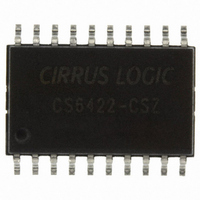CS6422-CSZ Cirrus Logic Inc, CS6422-CSZ Datasheet - Page 39

CS6422-CSZ
Manufacturer Part Number
CS6422-CSZ
Description
IC SPEAKERPHONE ENHANCED 20SOIC
Manufacturer
Cirrus Logic Inc
Type
Audio Processorr
Datasheet
1.CS6422-CSZ.pdf
(48 pages)
Specifications of CS6422-CSZ
Package / Case
20-SOIC
Applications
Speakerphones
Mounting Type
Surface Mount
Product
General Purpose Audio Amplifiers
Available Set Gain
34 dB
Thd Plus Noise
0.03 %
Operating Supply Voltage
5 V
Supply Current
10 mA, 50 mA
Maximum Operating Temperature
+ 70 C
Mounting Style
SMD/SMT
Audio - Load Impedance
10 KOhms
Input Offset Voltage
2.12 V
Minimum Operating Temperature
0 C
Supply Voltage (max)
5.5 V
Supply Voltage (min)
4.5 V
Rohs Compliant
Yes
Operating Temperature Range
0°C To +70°C
Digital Ic Case Style
SOIC
No. Of Pins
20
Lead Free Status / RoHS Status
Lead free / RoHS Compliant
Lead Free Status / RoHS Status
Lead free / RoHS Compliant, Lead free / RoHS Compliant
Other names
598-1200-5
Available stocks
Company
Part Number
Manufacturer
Quantity
Price
Company:
Part Number:
CS6422-CSZ
Manufacturer:
CIRRUS
Quantity:
61
Company:
Part Number:
CS6422-CSZ
Manufacturer:
CIRRUS
Quantity:
4
Part Number:
CS6422-CSZ
Manufacturer:
CIRRUS
Quantity:
20 000
Company:
Part Number:
CS6422-CSZR
Manufacturer:
CREE
Quantity:
210
The three pins that comprise the Microcontroller
Interface are STROBE, DATA, and DRDY. Also,
four extra clocks are required after DRDY is
brought high in order to latch the data into the
CS6422, as is shown in Figure 7.
4.2.2
Proper grounding of the CS6422 is necessary for
optimal performance from this mixed-signal de-
vice. The CS6422 should be considered an analog
device for grounding purposes.
The digital sections of the CS6422 are synchro-
nized with its ADCs and DACs to minimize the ef-
fects of digital noise coupling. However, for
external digital devices that are asynchronous with
respect to the CS6422, precautions should be taken
to minimize the chances of digital noise coupling
into the CS6422.
A design with the CS6422 should have a separate
ground plane for any digital devices. For example,
a system microcontroller should be on a digital
ground plane with its control lines leading to the
CS6422 in the shortest reasonable distance. The
CS6422 itself should lie completely on the analog
ground plane.
4.2.3
The physical layout of the traces and components
around the CS6422 will also strongly affect the per-
formance of the device. Special attention must be
paid to decoupling capacitors, the crystal oscillator,
and the input anti-aliasing filters.
The decoupling capacitors for the power supplies
of the CS6422 should be placed as close as possible
to the power pins for best performance. There are
two capacitors per pin: the 0.1 µF capacitor needs
to be closest to the pin to decouple the high fre-
quency components, and the larger cap can be far-
ther away. The MB pin is the most critical as it
connects directly to the on-chip voltage reference.
AVDD and DVDD are secondary to MB with re-
spect to priority.
DS295F1
Grounding Considerations
Layout Considerations
The crystal oscillator should be placed as close as
possible to reduce the distance that the high fre-
quency signals must travel. If the crystal is placed
too far away, the trace inductance may cause prob-
lems with oscillator startup.
The next concern with placement is the input anti-
aliasing filters for the ADC inputs. NI has an RC
low-pass network with a corner frequency of
8 kHz. The capacitor of this low-pass network
should be placed very close to the pin so that there
is very little exposed trace to pick up noise. If the
on-chip microphone amplifier is used, the 0.022 µF
capacitor on APO will provide the appropriate cut-
off frequency, and so should be placed close to the
APO pin. If the on-board preamplifier is not used,
APO will have the same RC network as NI, and
should be treated similarly.
The connections from the controller to the Micro-
controller Interface should be short straight traces,
if possible. The traces should not run very close to
any digital clocks to avoid cross coupling.
4.3
The CS6422 is ultimately only one part of a bigger
full-duplex hands-free system. In order for that sys-
tem to work well, it needs to be properly balanced.
The distribution of the system gains will make or
break the echo canceller. In order to judge perfor-
mance, however, the system integrator must be
armed with the means to test the product.
4.3.1
The distribution of the system gains is an important
design consideration to keep in mind. Gain distri-
bution is an intricate balancing act where the sys-
tem integrator tries to maximize dynamic range
while minimizing noise, and at the same time, get-
ting excellent echo canceller performance.
The basic constraint on getting good echo canceller
performance is that the maximum output should
not clip when coupled to the input. For example, if
in a speakerphone, AO provides 1.1 V
System Design
Gain Structure
CS6422
CS6422
rms
to a
39
39

















